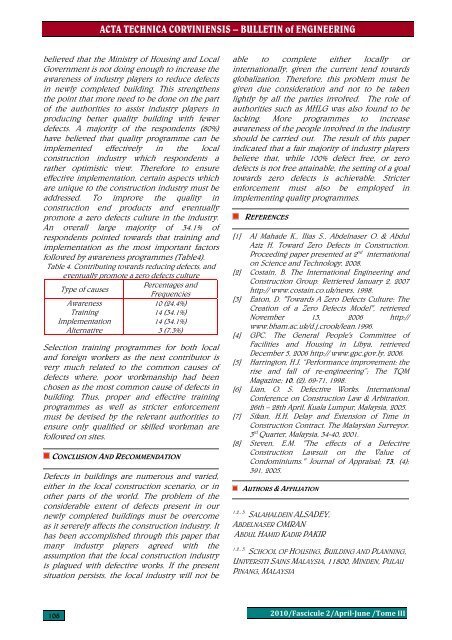ACTA TECHNICA CORVINIENSIS - Bulletin of Engineering
ACTA TECHNICA CORVINIENSIS - Bulletin of Engineering
ACTA TECHNICA CORVINIENSIS - Bulletin of Engineering
- No tags were found...
Create successful ePaper yourself
Turn your PDF publications into a flip-book with our unique Google optimized e-Paper software.
<strong>ACTA</strong> <strong>TECHNICA</strong> <strong>CORVINIENSIS</strong> – BULLETIN <strong>of</strong> ENGINEERINGbelieved that the Ministry <strong>of</strong> Housing and LocalGovernment is not doing enough to increase theawareness <strong>of</strong> industry players to reduce defectsin newly completed building. This strengthensthe point that more need to be done on the part<strong>of</strong> the authorities to assist industry players inproducing better quality building with fewerdefects. A majority <strong>of</strong> the respondents (80%)have believed that quality programme can beimplemented effectively in the localconstruction industry which respondents arather optimistic view. Therefore to ensureeffective implementation, certain aspects whichare unique to the construction industry must beaddressed. To improve the quality inconstruction end products and eventuallypromote a zero defects culture in the industry.An overall large majority <strong>of</strong> 34.1% <strong>of</strong>respondents pointed towards that training andimplementation as the most important factorsfollowed by awareness programmes (Table4).Table 4. Contributing towards reducing defects, andeventually promote a zero defects culturePercentages andType <strong>of</strong> causesAwarenessTrainingImplementationAlternativeFrequencies10 (24.4%)14 (34.1%)14 (34.1%)3 (7.3%)Selection training programmes for both localand foreign workers as the next contributor isvery much related to the common causes <strong>of</strong>defects where, poor workmanship had beenchosen as the most common cause <strong>of</strong> defects inbuilding. Thus, proper and effective trainingprogrammes as well as stricter enforcementmust be devised by the relevant authorities toensure only qualified or skilled workman arefollowed on sites.CONCLUSION AND RECOMMENDATIONDefects in buildings are numerous and varied,either in the local construction scenario, or inother parts <strong>of</strong> the world. The problem <strong>of</strong> theconsiderable extent <strong>of</strong> defects present in ournewly completed buildings must be overcomeas it severely affects the construction industry. Ithas been accomplished through this paper thatmany industry players agreed with theassumption that the local construction industryis plagued with defective works. If the presentsituation persists, the local industry will not beable to complete either locally orinternationally, given the current tend towardsglobalization. Therefore, this problem must begiven due consideration and not to be takenlightly by all the parties involved. The role <strong>of</strong>authorities such as MHLG was also found to belacking. More programmes to increaseawareness <strong>of</strong> the people involved in the industryshould be carried out. The result <strong>of</strong> this paperindicated that a fair majority <strong>of</strong> industry playersbelieve that, while 100% defect free, or zerodefects is not free attainable, the setting <strong>of</strong> a goaltowards zero defects is achievable. Stricterenforcement must also be employed inimplementing quality programmes.REFERENCES[1] Al Mahade K., Ilias S., Abdelnaser O. & AbdulAziz H. Toward Zero Defects in Construction.Proceeding paper presented at 2 nd internationalon Science and Technology, 2008.[2] Costain, B. The International <strong>Engineering</strong> andConstruction Group. Retrieved January 2, 2007http:// www.costain.co.uk/news, 1998.[3] Eaton, D. "Towards A Zero Defects Culture: TheCreation <strong>of</strong> a Zero Defects Model", retrievedNovember 13, 2006 http://www.bham.ac.uk/d.j.crook/lean.1996.[4] GPC. The General People's Committee <strong>of</strong>Facilities and Housing in Libya, retrievedDecember 5, 2006 http:// www.gpc.gov.ly, 2006.[5] Harrington, H.J. “Performance improvement: therise and fall <strong>of</strong> re-engineering”; The TQMMagazine; 10, (2), 69-71, 1998.[6] Lian, O. S. Defective Works. InternationalConference on Construction Law & Arbitration.26th – 28th April, Kuala Lumpur, Malaysia, 2005.[7] Sikan, H.H. Delay and Extension <strong>of</strong> Time inConstruction Contract. The Malaysian Surveyor.3 rd Quarter, Malaysia, 34-40, 2001.[8] Steven, E.M. "The effects <strong>of</strong> a DefectiveConstruction Lawsuit on the Value <strong>of</strong>Condominiums." Journal <strong>of</strong> Appraisal; 73, (4);391, 2005.AUTHORS & AFFILIATION1.2., 3.SALAHALDEIN ALSADEY,ABDELNASER OMRANABDUL HAMID KADIR PAKIR1.2., 3.SCHOOL OF HOUSING, BUILDING AND PLANNING,UNIVERSITI SAINS MALAYSIA, 11800, MINDEN, PULAUPINANG, MALAYSIA1082010/Fascicule 2/AprilJune /Tome III
















